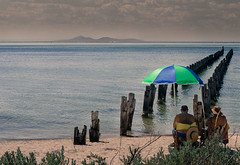With Sony’s announcement this week of their expected 24.6mp full frame A900 dSLR (and presumably Nikon will follow suit with the same sensor in the near future), what is the likely future of the full frame (and APS-C and DX cropped sensor cameras)?
To understand this, one first needs to be cognizant of the resolution capability of lenses. Most lenses designed in the 35mm film days (and still are the majority of those used on Canon & Nikon dSLRs) only needed to provide ~14mp resolution on a full frame film.
With the advent of the 16.7mp Canon 1DsMII and then the 21mp 1DsMIII it became clear that even the Canon L zooms (the best Canon zooms) struggled to give edge to edge resolution on a full frame sensor at 16mp, and to make the most of these sensors one really needed to use high quality (preferably L quality) prime lenses.
Olympus realised this and its Four Thirds lenses have much greater resolution than OM film lenses in order to deal with the 2x crop Four Thirds sensor, and in addition they decided on a telecentric optic design to minimise vignetting which otherwise tends to occur with oblique light rays hitting microlenses on the sensor.
For most people 10mp images are adequate as they will allow up to 20″x30″ high quality prints, but there will be some who need more for larger prints or for professional purposes where clients demand higher resolutions.
The problem with bumping up the megapixels on a sensor is 5-fold: more noise at higher ISO, less dynamic range, more demands on the spatial resolution of lenses, larger file size on your memory cards and computer, and potentially slower burst rates with the larger file sizes.
Now from a lens point of view, it is pointless having a 15mp APS-C cropped sensor camera if your lens will only provide detail for a 10mp image on that sensor – you just end up making bigger files but no more detail. We saw this with many of the point and shoot cameras as they went up above 5mp.
Just to re-iterate, a 15mp APS-C sensor has the same spatial resolution of a 38mp full frame sensor and the same as a 10mp Four Thirds sensor, so you are going to need very high resolution lenses.
But the larger the sensor, the harder it is and the more expensive it is, to make high resolution lenses, so it will be interesting to see how the new Canon 50D really fares, or is the extra 5mp just going to be wasted space on your memory card or computer?
So if 10mp is probably the optimum resolution on cropped sensors when used with the current best lenses, 16mp is probably the optimum on full frame sensors UNLESS you use new high quality lenses designed for digital (such as the very nice new Nikon wide angle zoom), in which case 21-25mp may be useful.
One advantage of a 21-25mp full frame is that, assuming you have a lens with adequate resolution to match it, you can crop it to a 8-10mp image (ie. in effect use 1.5x digital zoom) to give 1.5x telephoto reach in effect. This means that a cropped sensor camera would become redundant as long as the burst rate of your full frame is adequate for your needs – and if the manufacturers did not mind cannibalising their cropped sensor market, they would allow their full frame cameras to function in cropped image mode at higher burst rates.
Of course, the main downsides of full frame are price (but this is coming down rapidly and won’t be so much of an issue), and size, weight.
I believe there will still be a place for the 10fps, low noise at high ISO, 10mp, 1.3x crop Canon 1DMIII for sports and action photography.
I have always held the view that there is not much future in the APS-C or DX formats – there is not much point buying dedicated lenses for these which have limited or no (as with Canon) role in use on the full frame cameras. Users of cropped sensor cameras are probably better off buying highest quality full frame lenses which can then be used on their cropped sensor dSLR as well as their full frame sensor dSLR, and eventually they won’t bother with their cropped sensor dSLR.
The problem with all this is that these outfits are big, heavy and expensive.
So in my view there is a big place for the Four Thirds system and Four Thirds Micro system with their smaller size, lighter bodies and lenses, longer telephoto reach and potentially innovative solutions which will be much more portable – after all, no matter how good your camera is, it won’t take a good photo if you don’t take it with you.
So where are we with the entry level full frame market place in 2008?
- Nikon D700 – 12.1mp, 5-8fps, low noise, live preview but no CCD-shift IS
- Sony A900 – 24.6mp, 5fps, CCD-shift IS but no live preview
- Canon 5DMII – still to be announced, probably no CCD-shift IS
- Nikon D??? – 24.6mp, 5fps, live preview but no CCD-shift IS?? maybe 2009











A very informative article again, Gary.
But I’m not sure of the idea that people are moving towards smaller equipment. For lenses, I can see that, but for the housing I’m not so sure. I teach photography, and when I show the different camera houses to my students, they all go for the heavier versions, and for instance the E4XX looses out because think it too small.
My second thought is that for the future I think we’ll see more and more people with double or triple setups like you have. Some times I wish for the dynamics and quality of full frame, but won’t spend my bucks on it until prices come down. It won’t mean that I’ll drop my Oly, just that I want a choice – and having choices is the credo of the 21 Century Consumer.
I think there are a LOT of people out there who don’t want to use dSLRs because they are too big.
The smaller dSLRs such as the E410/420 do not suit people with big hands but for everyone else would be perfect EXCEPT Olympus didn’t put IS in it, and that is the main reason why I would never recommend them – I would rather have a bigger E510 with IS than a smaller E420 without IS.
The pro’s will tend to use full frame and I will follow suit for some of my photography BUT for portability, telephoto reach the Four Thirds and Micro Four Thirds will definetely have a place for me and for an increasing multitude of others, especially if, as I suspect, Canon & Nikon gradually abandon their cropped sensor cameras, at least with regard to high quality dedicated lenses.